Celebrating Yule with Elder Futhark Runes
Yule, a pivotal celebration within Norse mythology, marks a period deeply ingrained in the traditions of ancient Germanic tribes. Although this festival coincided with winter solstice, embraced by modern Norse pagans and those fascinated by Viking lore today, Yule was also about remembering and honoring the Dead who were awaiting rebirth while residing either in the lower or upper worlds of Yggdrasil after physical death.
Elder Futhark runes, the oldest form of runic alphabet used by these ancient cultures, play a significant role in today’s Yule festivities. The runes are not just letters, but powerful symbols used to invoke magic, divine the future, and bring blessings during this darkest time of the year. Their use in modern celebrations connects participants with their spiritual heritage, enhancing both the mystique and the authenticity of the holiday observance.
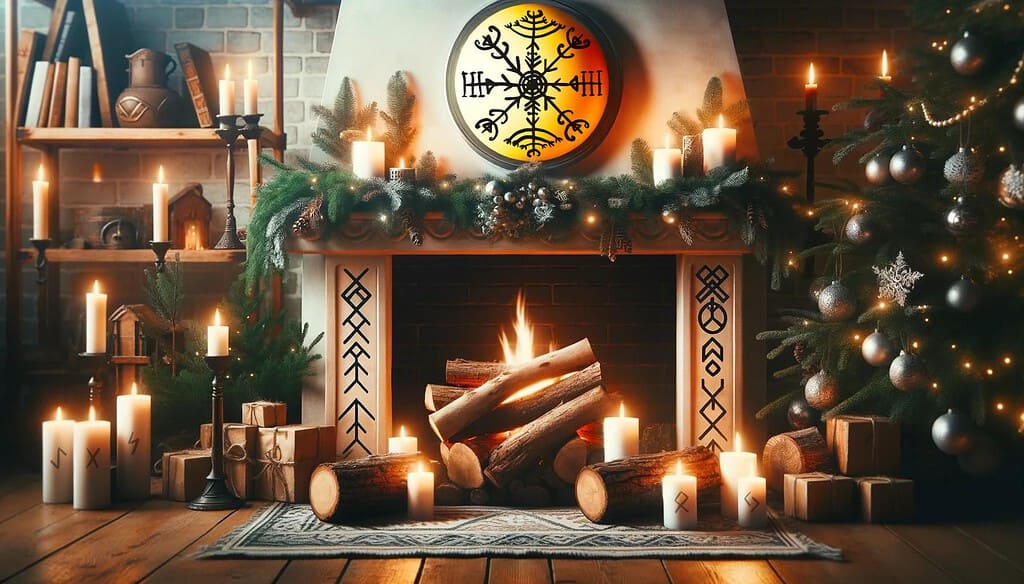
Table of Contents
Understanding Norse Runes and Yule
The Significance of Yule in Norse Tradition
Yule, or Jul, as it was known among the ancient Germanic tribes, coincides with the winter solstice, the longest night of the year. This festival was not only a time to celebrate the rebirth of the sun but also an essential moment for community gathering and ritualistic practices aimed at ensuring prosperity for the coming year.
As such, Yule has evolved from a seasonal observance to a key element of modern pagan celebrations, marked by a blend of reverence for nature and homage to ancestral traditions. For today’s Norse pagans, it bridges the gap between the old and the new, infusing ancient customs with contemporary meaning.
Overview of Elder Futhark Runes
The Elder Futhark, named after the first six runes (F, U, Þ, A, R, K), is the oldest form of the runic alphabets, used by the Germanic tribes from roughly the 2nd to the 8th centuries. Each rune is more than a letter; it is a symbol steeped in mythological and cosmological significance. Runes were used for a variety of purposes, from everyday writing to magical and religious rituals. In the context of Yule, runes are particularly poignant.
They are thought to hold the power to influence the world around them, offering protection, prosperity, and a means to divine the unfolding year. Today, runes are not only studied for their historical linguistic value but also embraced as tools for personal and spiritual development within the Norse pagan community.
Runes and Modern Yule Celebrations
The integration of runes into Yule celebrations is a reflection of their enduring relevance. By inscribing runes on candles, carving them into Yule logs, or using them in ceremonial blessings, modern practitioners connect with the mystical energies believed to govern these ancient symbols. This practice enriches the Yule festivities, making them a deeply personal and spiritually significant experience for those who walk the path of Norse paganism.
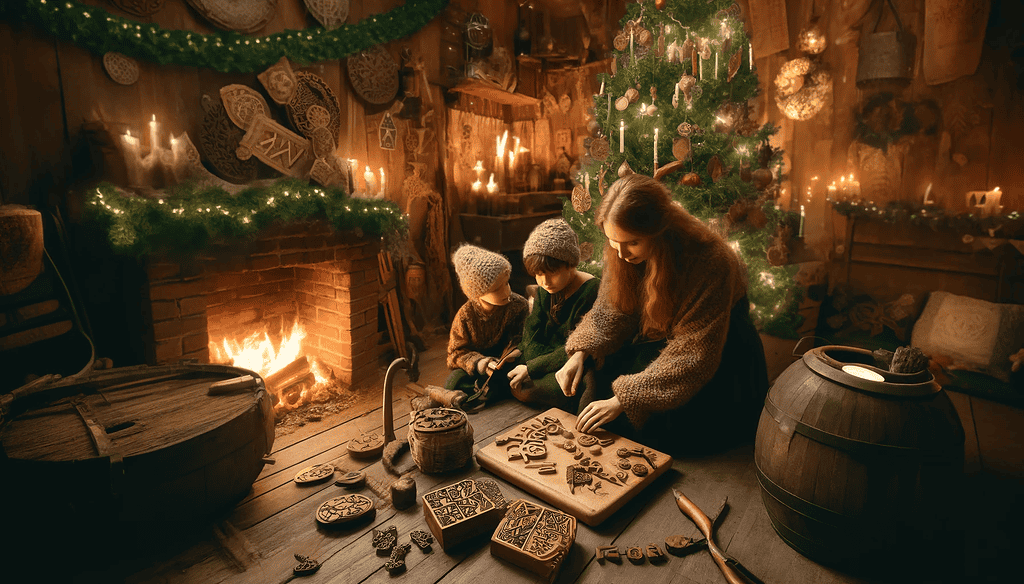
Key Runes for Yule Celebrations
Key Runes and Their Significance in Yule Celebrations
| Rune | Name | Symbolism | Yule Significance | Ways to Use During Yule |
|---|---|---|---|---|
| ᛃ | Jera | Harvest, cycles | Represents completion and renewal, aligned with the rebirth of the sun. | Carve on Yule logs, or use in decorating the home to symbolize hope for the new year. |
| ᛋ | Sowilo | The sun | Signifies the return of the sun, crucial for Yule as the turning point towards longer days. | Place in sunny areas, make sun wheel decorations, or include in rituals to honor the sun. |
| ᛇ | Eihwaz | The yew tree | Embodies transformation and eternal life, resonating with themes of death and rebirth in Yule. | Use in protective amulets, or decorate doorways and windows to safeguard the home. |
| ᚷ | Gebo | Gift-giving, generosity | Represents the spirit of generosity, a central aspect of Yule festivities. | Attach to gifts, or use in crafting gift tags and cards to enhance the spirit of giving. |
Jera – The Rune of Harvest and Cycles
Jera, the rune that represents the annual harvest cycle, is deeply connected to the themes of Yule. Symbolizing both completion and renewal, Jera reflects the cyclical nature of the seasons, mirroring the death and rebirth themes prevalent during Yule. As the old year closes and a new one begins, Jera embodies the promise of renewal and the continuation of life. During Yule, this rune is often used in rituals and decorations to emphasize hope for a fruitful year ahead and to honor the natural balance of the world.
Sowilo – The Sun’s Rune
Sowilo marks the rune of the sun, a symbol of light and victory, which resonates powerfully with Yule, the festival celebrating the sun’s return after the longest night of the year. Its shape, reminiscent of a lightning bolt, suggests not only illumination but also the spiritual enlightenment and the victory of light over darkness. Sowilo’s presence in Yule celebrations serves as a potent reminder of the sun’s strength and its cyclical journey across the sky, promising warmth and renewed energy for the coming months. Invoking Sowilo during Yule can be seen as a magical act to hasten the return of the sun and to celebrate its life-giving force.
Eihwaz – The Yew Tree Rune
Eihwaz symbolizes the yew tree, known for its association with both death and eternal life due to the tree’s longevity and evergreen nature. This rune embodies endurance, transformation, and the eternal cycle of life and death, themes that echo strongly in the observance of Yule. Eihwaz is used during Yule to symbolize the resilience required to endure the winter and the promise of rebirth in the spring. It serves as a powerful reminder of the impermanence of death and the continuity of life, offering spiritual support and protection during the darkest days of the year.
Gebo – The Gift Rune
Gebo, representing the rune of gift-giving and generosity, captures the spirit of Yule perfectly. This rune signifies the balance of giving and receiving, a principle that lies at the heart of Yule traditions. The exchange of gifts during Yule is a practice steeped in the symbolic meaning of Gebo, fostering community bonds and mutual respect among participants. Incorporating Gebo into Yule festivities not only honors these ancient customs but also revitalizes the joy and spirit of generosity that characterizes the season.
The Relevance of These Runes in Modern Celebrations
In modern Norse pagan practices, these runes are not merely symbols from a bygone era; they are vibrant, living aspects of spiritual heritage. They are woven into Yule crafts, such as rune-carved Yule logs, rune-stamped holiday cards, and candles marked with these sacred symbols, to enhance the festive and ceremonial atmosphere. For practitioners, these runes offer a direct link to their ancestors, providing a tangible connection to the wisdom and traditions of the past, while also enriching their contemporary celebrations with depth and authenticity.
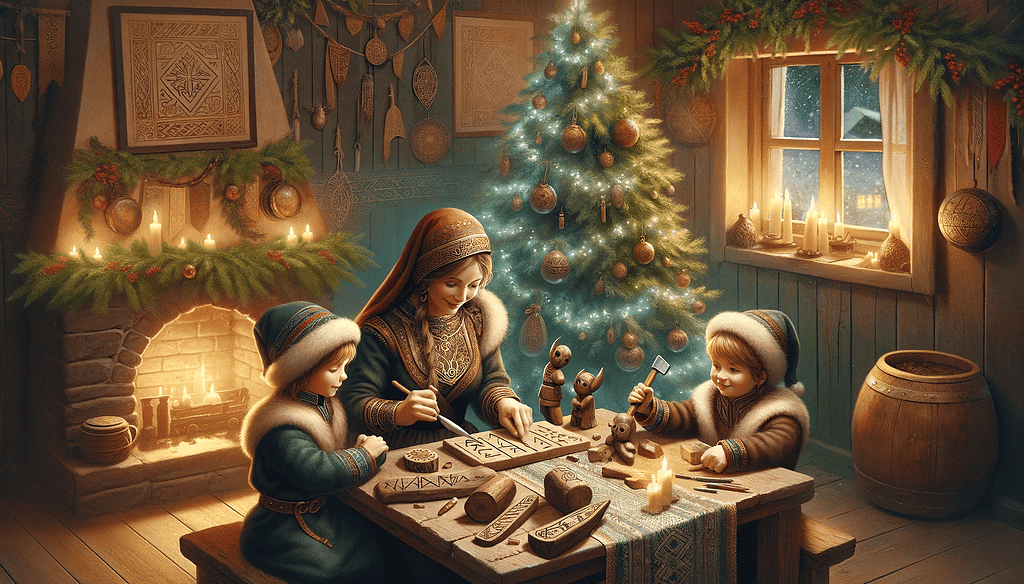
Crafting with Runes: Expanded Yule Crafts
DIY Rune Ornaments
Create personalized ornaments by carving or painting runes on materials such as wood, clay, or even thick cardstock. These can be hung on a Yule tree or around the home to bring in the energies of the runes during the festive season.
Creating Rune-Inspired Yule Garlands
Fashion garlands using natural materials like branches, twigs, and dried berries, interspersed with symbols like the Elder Futhark runes. These garlands can be draped over mantels, doorways, or around the Yule tree to enhance the festive decor.
Rune-Adorned Yule Cards
Design unique holiday cards that incorporate runes along with traditional Yule motifs such as evergreens, snowflakes, and the Yule log. These cards can be a wonderful way to send wishes of joy, prosperity, and magical blessings to friends and family.
Runes on Yule Candles
Customize candles by carving runes into the wax or painting them on the candle’s surface. These candles can be used to focus on specific intentions during Yule rituals or simply to create a mystical ambiance during the celebrations.
Rune-Stamped Gift Wrapping
Utilize rubber stamps or hand-draw runes on wrapping paper to personalize the gifts you give. This touch not only beautifies the gift but also infuses it with deeper meaning and intention, making the act of giving even more special.
Rune-Inspired Wall Hangings
Craft wall hangings that feature runes woven into designs with fabrics, beads, or threads. These can be tailored to specific runes that resonate with the maker’s intentions, making them ideal for personal use or as thoughtful gifts.
Yule Rune Table Runners
Create table runners adorned with runes for festive dining settings. These can set the tone for a Yule feast, aligning the gathering with themes of renewal, prosperity, or protection.
Runes and Natural Elements Centerpieces
Combine runes with natural elements like pine cones, evergreen branches, and holly to create unique centerpieces. These centerpieces not only beautify the table setting but also bring the magic and meaning of runes directly into the heart of Yule celebrations.
Rune-Decorated Pottery
Embellish pottery such as mugs, bowls, or serving dishes with runes. This not only makes each piece unique but also infuses Yule meals with the energies of the runes, enhancing the communal and sacred aspects of dining together.
Yule Tree Rune Charms
Make small charms with runes inscribed on them to hang on the Yule tree. Each charm can carry specific intentions such as protection, prosperity, or health, serving as both decoration and magical talisman for the coming year.
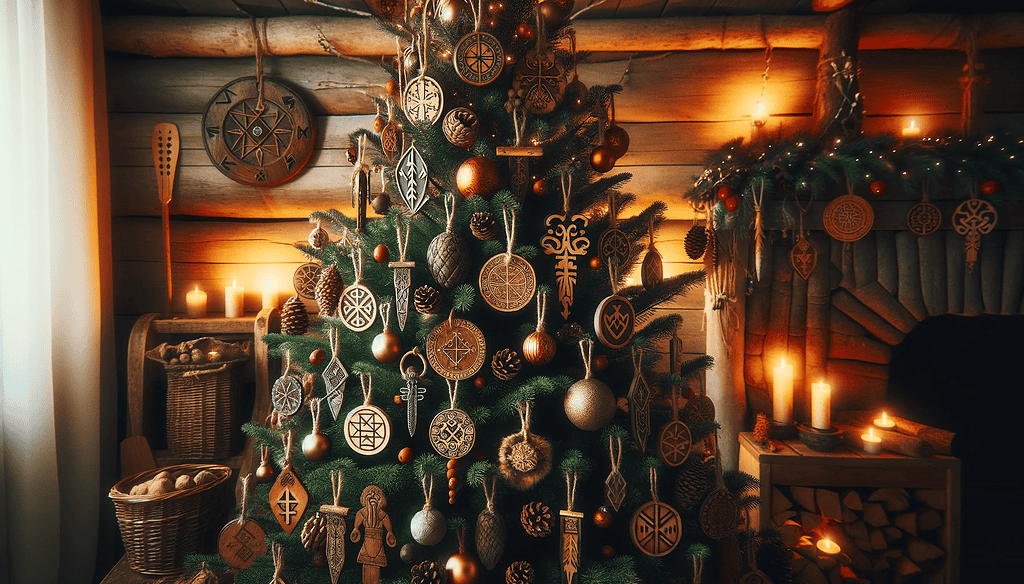
Odin: The Original Santa Claus?
Exploring the Connection Between Odin and Santa Claus
The festive figure of Santa Claus, known for his generosity and annual gift-giving, bears a striking resemblance to Odin, the revered god in Norse mythology. This connection is not merely superficial but rooted deeply in the traditions and legends of Northern Europe. Odin, a central figure in Norse mythology, is often depicted as a wanderer, a wise old man with a long beard, much like the modern depiction of Santa Claus. During the Yule season, Odin was said to lead a great hunting party across the sky, a mythological event known as the Wild Hunt.
Odin’s Gifts and the Wild Hunt
Odin’s role during the Wild Hunt and his overall persona as a benevolent and magical figure have contributed significantly to the modern characteristics of Santa Claus. During this mythic procession through the heavens, Odin was believed to visit homes and leave gifts, paralleling Santa’s Christmas Eve journey. Moreover, Odin’s two ravens, Huginn and Muninn, who flew around the world and brought him information, could be seen as precursors to Santa Claus’s list of who’s naughty and nice.
Sleipnir: The Eight-Legged Steed and Santa’s Reindeer
Furthermore, Odin rode Sleipnir, an eight-legged horse, capable of leaping great distances—echoes of which we see in Santa Claus’s reindeer-led sleigh. The eight legs of Sleipnir can be thought of as a precursor to the eight reindeer traditionally said to pull Santa’s sleigh, bridging these two iconic winter figures across cultures and centuries. This imagery was likely transformed as Viking stories were woven with Christian folklore across Northern Europe, blending Odin’s mythological traits with the developing figure of St. Nicholas, eventually evolving into the Santa Claus we know today.
Cultural Syncretism: The Blending of Norse and Christian Traditions
The transformation of these Yule traditions shows a fascinating cultural exchange and adaptation. As Norse settlers and their descendants came into contact with Christian traditions, elements of the old pagan beliefs were integrated into the new religious practices. This syncretism is a key factor in how pagan symbols and deities have been adapted to fit Christian celebrations, contributing to the rich tapestry of holiday customs in the modern world.
Odin’s Legacy in Modern Yule Celebrations
The recognition of Odin in the traits and stories of Santa Claus provides a powerful example of how ancient beliefs can shape and influence contemporary customs. For modern Norse pagans, this connection serves as a reminder of their spiritual heritage, enriching their celebration of Yule with layers of meaning and historical continuity. Engaging with these traditions allows for a deeper appreciation of the past, while celebrating the present, and looking forward to the future.
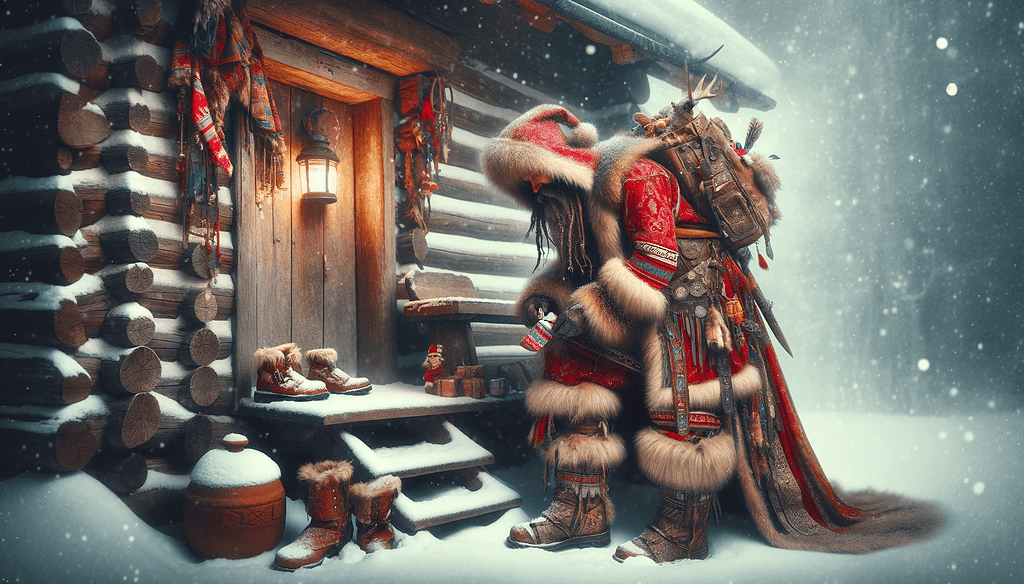
The Yule Goat: A Norse Legacy
Exploring the Norse Origins of the Yule Goat
The Yule Goat is one of the most distinctive and enduring symbols of Yule, deeply rooted in Norse and broader Scandinavian traditions. This iconic figure originates from ancient Pagan festivals, where the goat was associated with the god Thor, who rode a chariot drawn by two goats. This connection emphasizes the goat’s significance in myth and its role in the winter celebrations.
In pre-Christian times, the Yule Goat was believed to be a spirit that visited homes to ensure that Yule preparations were done properly and, in some tales, was a giver of gifts, much like the later figures of St. Nicholas or Santa Claus. The tradition has evolved, but the Yule Goat remains a prominent feature in modern Scandinavian Christmas decorations and celebrations, typically made from straw and bound with red ribbons, symbolizing protection and fertility.
The Yule Goat in Modern Celebrations
Today, the Yule Goat is most famously represented in the large straw goat erected annually in Gävle, Sweden, a practice that began in 1966. The Gävle Goat has become a global symbol of Christmas in Sweden, attracting visitors and sometimes vandals, reflecting its playful role in contemporary festive culture. The making of smaller Yule Goats, whether as ornaments for the Christmas tree, centerpieces for the holiday table, or even as characters in holiday plays and parades, continues to be a popular tradition throughout Scandinavia.
The persistence of the Yule Goat in holiday traditions not only honors the historical significance of the goat in ancient Norse culture but also highlights the enduring nature of these pagan elements in modern Christian celebrations. For those in the Norse pagan community, crafting a Yule Goat can be a meaningful way to connect with their heritage and observe the Yule season with a symbol that is both ancient and continually relevant.
This connection serves as a reminder of the layers of history and tradition that shape our holiday practices today. By embracing the Yule Goat, modern Norse pagans and enthusiasts of Viking culture can enrich their celebrations, blending the old with the new in a festive tribute to the past.
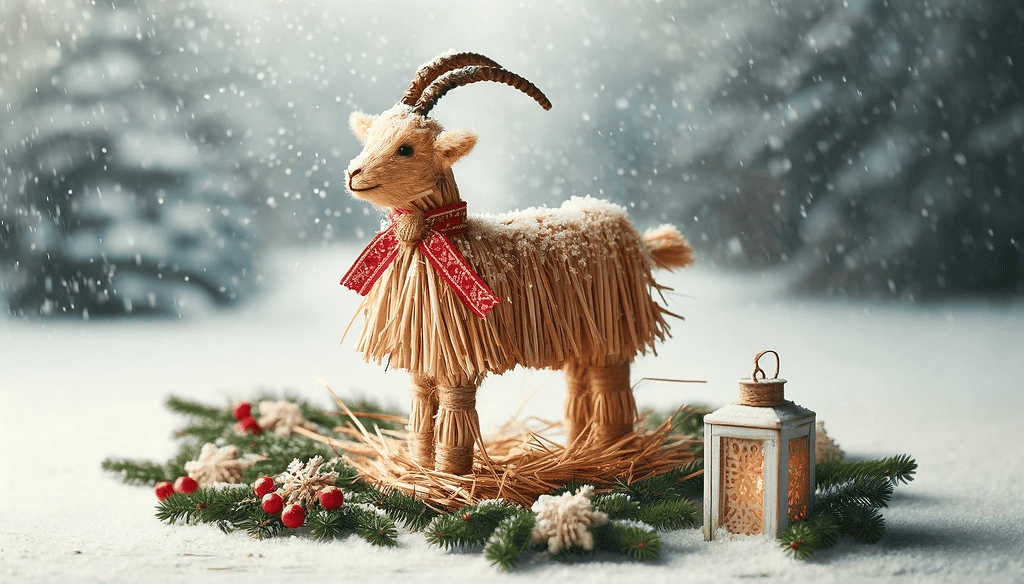
Mythological Beasts of Yule: Nisse and Tomte
Nisse and Tomte: Guardians of the Hearth
The Nisse or Tomte are fascinating figures in Scandinavian folklore, often associated with the winter solstice and Yule. Traditionally depicted as small, elderly men with long beards and conical hats, these spirits are said to protect the household and farm animals from misfortune. In Norse mythology and folklore, they are both respected and feared; families would treat them with respect and leave offerings, particularly during Yule, to curry their favor for the coming year.
Modern interpretations of the Nisse and Tomte have softened their more mischievous and stern characteristics, transforming them into more benevolent figures akin to Santa Claus. They are commonly depicted in holiday decorations and children’s stories, bringing gifts to those who have been good and playing harmless pranks on those who haven’t. During Yule, these creatures symbolize a bridge between the supernatural and the everyday, embodying a blend of pagan traditions and modern festive cheer.
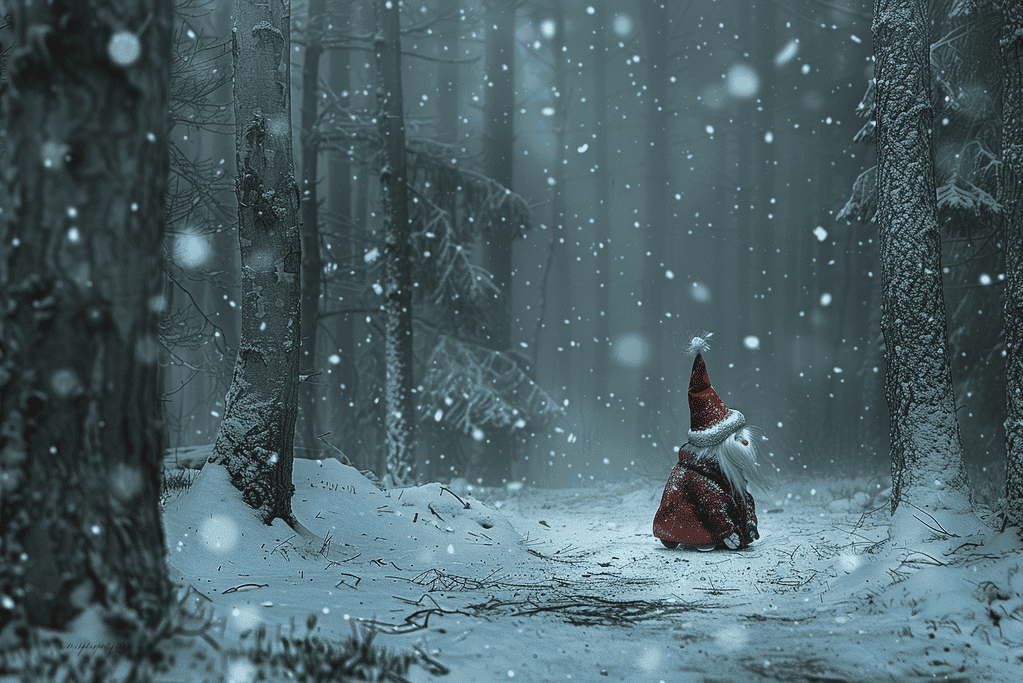
Yule in Different Cultures
Yule Traditions Across the Norse-Influenced World
The celebration of Yule has deep roots in Norse tradition, but its modern observance varies widely across different cultures influenced by Norse heritage. These variations highlight the adaptability and enduring appeal of these ancient customs.
- Iceland: In Iceland, Yule (or ‘Jól’) is celebrated with a mix of Christian and pagan traditions. One of the most unique is the Yule Lads; originally figures of mischief, they have been transformed into Santa-like characters, each with their own personality and role during the holiday season.
- Norway: In Norway, the celebration is strongly connected to the idea of the return of the sun. People light candles and fires to symbolize the sun’s warmth and life-giving properties. The Yule log, decorated and burned, is a central feature, symbolizing light enduring through the dark months.
- Sweden: Sweden’s Yule is perhaps best known for its St. Lucia’s Day, which ushers in the season with processions featuring young girls in white gowns and red sashes, wearing crowns of candles. The Yule Goat, a major symbol made of straw, is a common sight in towns and homes.
- Denmark: Danish Yule is celebrated with a focus on community and family. It’s common for towns to have large communal feasts and dances. The concept of ‘hygge’, or coziness, permeates the celebrations, with a focus on indoor activities like crafting and baking.
- The British Isles: In parts of the British Isles influenced by Norse settlers, such as the Orkney and Shetland Islands, Yule traditions blend Norse and Celtic practices. The burning of the Clavie (a barrel full of tar set on fire) and fire festivals light up the night, celebrating the sun’s return.
These diverse practices illustrate how Yule, rooted in Norse mythology and the celebration of the winter solstice, has been adapted across cultures, each adding its unique flavor while retaining the core themes of renewal, light, and community.
The Timeless Tradition of Yule
As we’ve explored the rich tapestry of Yule traditions, from the enchanting Nisse and Tomte of Scandinavian folklore to the diverse celebrations across countries steeped in Norse culture, it’s clear that Yule is more than just a historical or religious observance. It is a vibrant, living tradition that continues to evolve and resonate with people today. Each element—from the mythological beings that visit our homes to the burning of the Yule log and the festive lights—carries deep symbolism and connection to the natural world and our ancestors.
For those who hold Norse mythology and pagan traditions dear, incorporating these elements into modern celebrations can provide a meaningful link to the past, enriched by the knowledge of how these customs have spread and adapted across different lands. Whether you’re crafting a rune-adorned garland, preparing a feast that honors the old gods, or simply telling stories of Odin and the origins of Santa Claus, you’re participating in a heritage that has been celebrated for millennia.
This Yule, let us embrace the warmth and light of these traditions. Let’s remember that, although the longest night of the year may be dark and cold, it also marks the beginning of the sun’s return and the renewal of life. In the spirit of Yule, we can all find ways to bring a little more light into our lives and the lives of others. Happy Yule to all, and may your celebrations be filled with joy and deep meaning.
